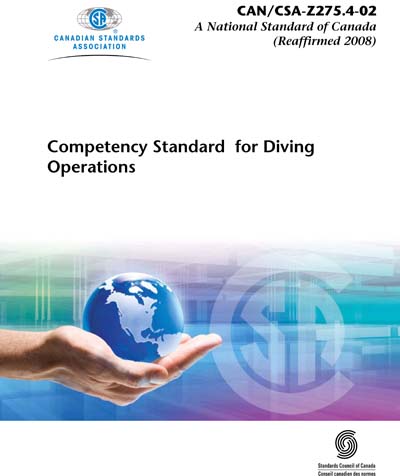Historical
CAN/CSA Z275.4-2002 (R2008)
CAN/CSA-Z275.4-02 (R2008) - Competency Standard for Diving Operations
Update #1 was published as notification that this is now a National Standard of Canada
1. Scope
1.1 This Standard applies to occupational diving operations conducted in connection with all types of work and employment, and describes the requirements for minimum competency levels for all personnel directly associated with the identified techniques of diving. Canadian safety and health legislation requires that all workers be competent to perform the work assigned to them. This lesgislation requires competency in both the theory and use of the type of diving apparatus employed. This Standard has been established to provide diver training facilities and the diving industry with a uniform minimum level of competency necessary for the various levels of diver techniques. This level of competency will allow the diver to safely and competently complete the specific tasks required of the occupational diver. Note: It is recognized that certain underwater tasks may require specialized codes of practice. Competency levels that differ from the requirements of this Standard may be acceptable to the regulatory authority.1.2 This Standard addresses competency requirements for the following: (a) occupational (open-circuit) SCUBA diving; (b) surface-supplied diving: (i) air (1) restricted surface-supplied; and (2) unrestricted surface-supplied; and (ii) mixed gas; (c) deep diving: (i) bell techniques (bell); (ii) saturation techniques (SAT); and (iii) atmospheric diving system techniques (ADS); and (d) diving and hyperbaric physicians.
1.3 This Standard addresses the competency requirements for the following types of personnel associated with the above diving techniques: (a) diver/pilot; (b) tender; (c) diving supervisor; (d) hyperbaric chamber operator (HCO); (e) life-support technician (LST); (f) diving medical technician (DMT); (g) diving safety specialist (DSS); and (h) diving and hyperbaric physician.
1.4 This Standard does not apply to diving operations performed solely for sport recreation or training therein. This Standard does not include work techniques associated with underwater diving operations.
1.5 The values given in SI (metric) units are the standard. The values given in parentheses are for information only.
1.6 This Standard does not apply to scientific diving as defined in Clause 2.1. For divers involved in scientific diving, refer to Standard of Practice for Scientific Diving, published by the Canadian Association for Underwater Science.
1.7 In this Standard, .shall. is used to express a requirement, i.e., a provision that the user is obliged to satisfy in order to comply with the standard; .should. is used to express a recommendation or that which is advised but not required; and .may. is used to express an option or that which is permissible within the limits of the standard. Notes accompanying clauses do not include requirements or alternative requirements; the purpose of a note accompanying a clause is to separate from the text explanatory or informative material. Notes to tables and figures are considered part of the table or figure and may be written as requirements. Legends to equations and figures are considered requirements.
Content Provider
CSA America, Inc. [csa]






